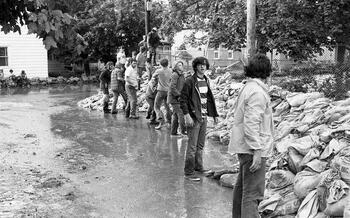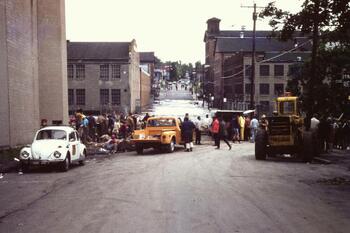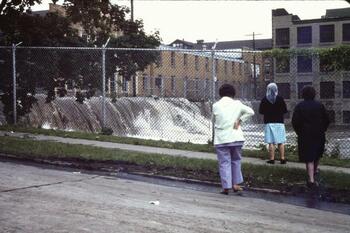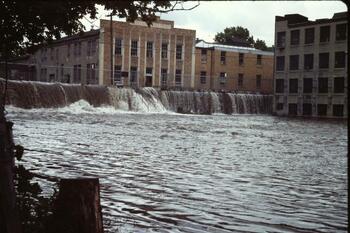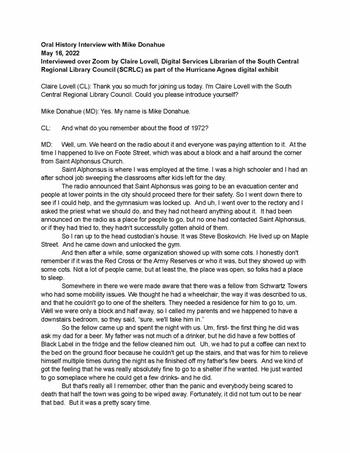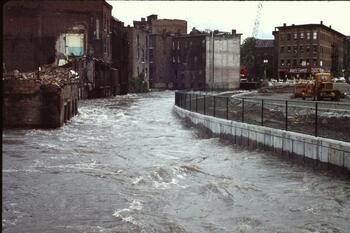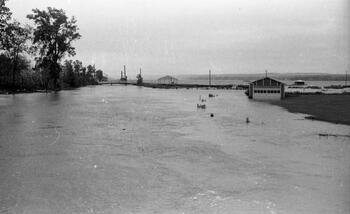The flooding hit Auburn on Sunday, June 25, two days after the destruction along the Southern Tier rivers. Government officials and engineers were concerned that a flood holding back the Owasco River was weakening. News from all over the state had reported the catastrophes that occurred in the southern counties of New York, so the city declared an evacuation order for 15,000 residents.
Local residents recall the high school graduation being canceled as the evacuation orders were placed. The evacuation order also interrupted a Class A New York-Penn League game between the Auburn Phillies and the Geneva Rangers, causing 3,000 fans to disperse until the next day.
Parts of Auburn did experience flooding, but the weakened dam held and most of the city was spared any damage.
Volunteers Sandbagging on West Street. Courtesy of the South Central Regional Library Council and John Paul Iaria.
Young people were called to action over the weekend and piled sandbags around the houses on West Street.
Flooded Washington Street. Courtesy of Seymour Public Library.
Auburn resident Stanley W Hojnacki photographed the area around Washington Street, where the former large employers, Dunn & McCarthy and Procino & Rossi, were located across the street from one another.
The buildings formerly of Dunn & McCarthy shoe company are no longer standing, having burned down during a fire on Sunday, December 19, 1993. The complex of brick buildings at 41-55 Washington St. had been empty for about three years, according to the Citizen newspaper in a 2018 article:
"The factory opened in 1891, giving John Dunn's company access to the nearby Owasco River to power its pioneering use of assembly line techniques in shoe manufacturing. With Charles McCarthy now a partner, Dunn & McCarthy would employ 2,000 people at the turn of the century and become a national name. But as shoe imports increased toward the turn of the next, that name suffered. In 1989, the descendants of Fred L. Emerson, who succeeded McCarthy as president, sold its stock in Dunn & McCarthy to a Roanoke company that filed for bankruptcy later that same year. After a failed loan payment the following year, the last order of 40,000 shoes was filled by 50 workers — and one of Auburn's biggest factories closed its doors."
Flooding near West Street. Courtesy of Seymour Public Library.
Three women stand on the road and sidewalk on West Street, looking at the flooding of the Owasco River near Washington Street. The buildings for Procino & Rossi are on the left and Dunn & McCarthy are on the right. The parking lot for Dunn & McCarthy was completely flooded.
Alfredo Rossi and Nicholas Procino founded Procino & Rossi (P&R) in Syracuse in the early 1920s. The business relocated to Auburn after a fire. In Auburn, they employed hundreds of people and distributed their pastas, sauces, and cheese throughout the northeast. Hurricane Agnes and the floods of 1972 wiped out their business, but they rebuilt it and sold the company to Hershey Foods in 1978.
Owasco River flooding near Procino & Rossi Macaroni Factory. Courtesy of Seymour Public Library.
Another view of the flooded Procino & Rossi factory, taken from West Street.
Flood of 1972 Interview with Mike Donahue. Courtesy of the South Central Regional Library Council.
Mike Donahue of Auburn talks about the flooding of June, 1972, when he worked as a teenager at St. Alphonsus Church. He heard on the radio that St. Alphonsus Church would be an evacuation site, as it was on higher ground from the river. He went by the church and discovered the doors were locked; the priests were not aware that their church was meant to be an evacuation site.
Owasco River in Downtown Auburn near Market Street Park. Courtesy of Seymour Public Library.
The Owasco River, running through downtown Auburn, was many feet higher than usual. A 1973 article by Kevin Althouse in the Citizen-Advertiser noted that the Market Street retaining wall, under construction on the right here, was over $364,000.
This area of Auburn was partially razed by Urban Renewal efforts. Both sides of the Owasco as seen in this picture have been rebuilt as a public park and performance space.
Emerson Park on Owasco Lake 1. Courtesy of the South Central Regional Library Council and John Paul Iaria.
Despite flood controls in place for the large lakes, Owasco Lake did still see record water levels. The park area around Emerson Park, in the southwest corner of Auburn, was flooded.
